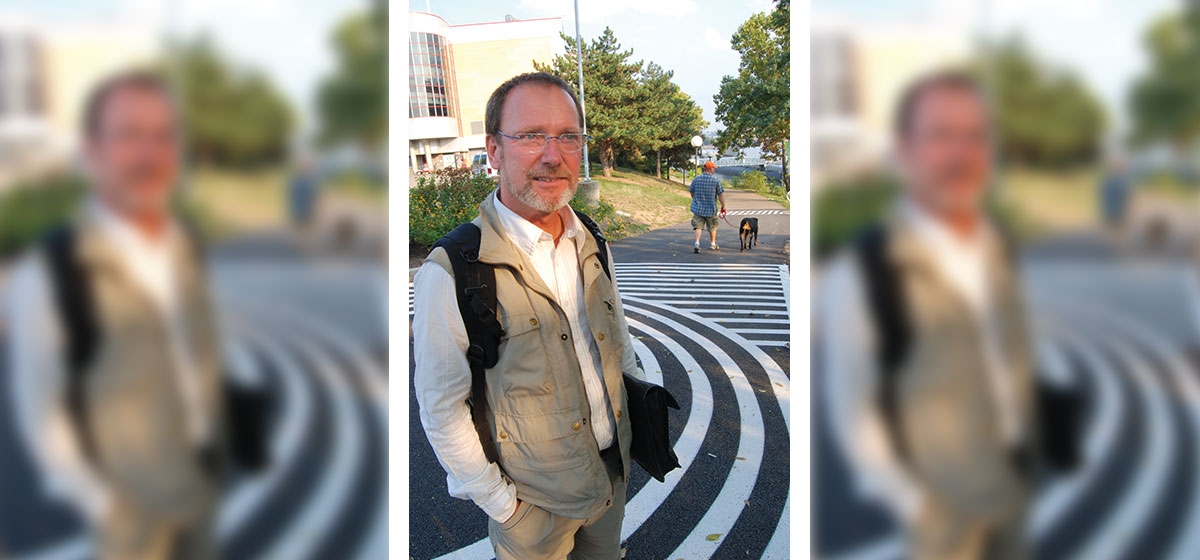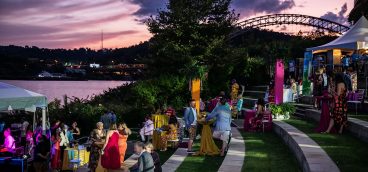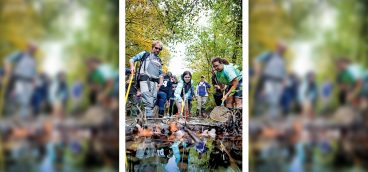
Herbert Dreiseitl was in a hurry to get back to work one day last February, so he did what most people do here. He jaywalked. He scuttled across Liberty Avenue — no cars were coming — and headed uptown, where his design team awaited him.
His hurry was understandable. Dreiseitl, a world-renowned urban designer who works primarily with water, was in town for a few days to redesign a rough and weedy section of the city’s riverfront near the West End Bridge. His task was to transform the tangle of railroad bed, junkyard and brownfield into a swath of green that would beckon both foot traffic and development.
It was the fourth consecutive week that Dreiseitl had been on the road. He lives in Überlingen, a medieval town in Southern Germany on Lake Constance where he has run his studio, Atelier Dreiseitl, since 1980. Dreiseitl, an affable, compact man with short-cropped reddish hair, mustache and goatee, had just been to Abu Dhabi, helping the emirate’s royal family with a sustainability plan. In a few days, he would be in Singapore, working on the tropical island city-state’s master plan for stormwater. While in Pittsburgh, Dreiseitl would be working with Riverlife, a public-private partnership formed in 1999 to redevelop the city’s riverfront. He’d sit in meetings, go on tours, draw and re-draw the riverfront with a pair of landscape architects he brought with him from his office in Überlingen.
Backpack over his shoulder, Dreiseitl arrived at Riverlife’s headquarters, inside the Regional Enterprise Tower (commonly known as the old Alcoa Building, aluminum elevator walls and all). Two of his landscape architects were clicking away at laptops in a room they had commandeered for the week. They had plastered the walls with schematic drawings, historic photographs and watershed maps. A long conference table was covered with tracing paper, bound reports and aerial photographs.
For the past several years, Riverlife has been piecing together portions of 3 Rivers Park, a 13-mile ribbon of parks and public access connections linked by a trail system on all three rivers near Downtown. Under the group’s guidance, about 80 percent of the trail is either complete or in some form of development. Most of the completed sections have been on public land. The remaining 20 percent is not. Most of it lies near the West End Bridge, on parcels owned by more than a dozen large-scale landowners — including the Pittsburgh Steelers, the Carnegie Science Center and the soon-to-be-built Majestic Star Casino. Getting these landowners to allow a public trail on their property, let alone one with bioswales and permeable paving, is no small order. That’s where Dreiseitl comes in. Riverlife brought his team to help create a “vision” for this last portion of the park, which Lisa Schroeder, the group’s executive director, calls “closing the loop.”
Dreiseitl sat down at one end of the conference table and placed a sheet of tracing paper over a map of the Ohio River shoreline near Station Square. Tracing the contour of the riverfront, he then drew several converging arcs — few of Herbert’s designs come with straight lines. He started talking with one of his landscape architects, Gerhard Hauber, a rangy man with long, curly hair pulled back into a pony tail. They pointed at Herbert’s drawing and started talking about restaurants, artists’ lofts, parklets, footpaths and wetland treatments. They spoke in German, but snippets of English crept into their conversation— “studio,” “café,” “boring.”
Every day they are on-site, Dreiseitl’s team makes new drawings, based on information gleaned from clients. “We don’t have all the answers,” Dreiseitl explains. “We are not coming to a region bringing our wisdom. We don’t want to repeat something we’ve done. We want to be very honest to the location, to the local culture.”
By the end of the week, Dreiseitl’s team had created an outline for a new riverfront. They drew meandering trails, small wetlands, landings for solar-powered water taxis and space for residential development, playing fields and concerts. His design breaks up the linear bank of the current riverfront into something more organic — artificial swales, small oxbows and wetlands splinter out from the river’s main stem to reference the transition between land and water. The designs re-route the riverfront trail over a building near the West End Bridge, thereby creating a viewing platform smack across the river from Downtown. In Dreiseitl’s green design, rainwater could be re-used and cleaned before reentering the rivers, improving water quality downstream. If they are built, the designs would represent a moonshot for Pittsburgh’s ongoing effort to redefine itself as a green city.
That’s a big if. The city’s fiscal difficulties are renowned; the region is still losing population and the city’s attention is elsewhere, focused on a new casino, light rail connection to the North Shore and hockey arena. So, how far and how fast will Dreiseitl and Riverlife be able to take the city’s riverfronts?
It’s a question Kathleen McKenzie, Allegheny County deputy manager, recently posed to Dreiseitl. She has seen several of Riverlife’s presentations on the West End project as an envoy for County Executive Dan Onorato.
“I said, ‘You know Herbert, I love your work, but how’s this going to work? We’ve got the (light rail extension) coming, we’ve got a casino coming, how’s this going to work?’ He said, ‘If you never show people what can get done, it’ll never get done.’ And he’s right.”
Chip Burke, the chairman of the Grable Foundation, said the city needs to aim high when rethinking its waterfront. That’s why the Grable Foundation, which focuses its giving on improving the quality of life for the area’s children, gave Riverlife $500,000 to hire Atelier Dreiseitl.
“We encouraged Riverlife to get a world-class designer. This town deserves a choice of what is the very best. If it came from the city government, they probably could not afford a world-class designer.”
Burke frowns on anyone who doubts that Dreiseitl’s daring vision will see the light of day.
“You can’t be a skeptic,” Burke said. “You’ve gotta believe.”
To a large extent, Dreiseitl and Riverlife’s vision is already making an impact. The Majestic Star Casino agreed to change its building plan to capture rainwater from its 4-acre roof and a 2-acre “hardscape” around the 3,000-slot facility in underwater pipes. (However, Riverfront is still battling the casino over a planned 3800-space parking garage overlooking the casino. An op-ed piece in the Post-Gazette penned by Riverlife’s chairman John C. Oliver and Schroeder call the garage “enormous” and “an unfortunate monument to shortsighted planning.”) The Carnegie Science Center has contracted with Dreiseitl to consult on a planned re-design of the center’s 13-acre property, including a possible stormwater recycling demonstration project, which could use the casino’s storm run-off.
“They were going to pipe all the stormwater straight into the river,” Schroeder said. “Convincing them to capture that water was huge.”
Dreiseitl was trained as a visual artist in Germany, but wanted to use his skills working on something that would reach a broader audience. As a young man, he worked as an art therapist for prisoners and drug addicts, before turning to design. In 1980, he started Atelier Dreiseitl. The firm soon began to take on large projects in Germany.
His most well-known installation is an urban water feature for Berlin’s Potsdamer Platz, in which rainwater from nearby office buildings flows into an artificial pond, and provides water for toilets and park irrigation.
Water is an active ingredient in virtually everything he designs: it flows down staircases, through open channels, into sound chambers, behind glass, through playgrounds. The mysterious nature of water, the way it vibrates, eddies and roils, is a constant theme in Dreiseitl’s design. His systems often combat soil erosion, water pollution and flooding by recycling and storing stormwater in settling ponds or constructed wetlands. Locally, Dreiseitl is designing an entryway to Frick Park for the Nine Mile Run Watershed Association, where he plans to incorporate stormwater into the design of a public green space.
Where many engineers think of rainwater as a problem, something to bury in pipes and whisk away, Dreiseitl thinks of it as something to play in.
“Herbert’s design works on a visceral level,” says Henry Kunowski, the project manager for Portland’s Tanner Springs Park, which Dreiseitl designed. Kunowski, an architectural historian, has seen many landscape architects base their designs around an abstract concept, or rational line of thought. Dreiseitl’s work is more immediate, more organic, he says. “The designs would speak for themselves. The synapses were connecting right away,” Kunowski said.
Tanner Springs exemplifies one of Dreiseitl’s central tenets: good design flows from understanding your location. Dreiseitl held a series of public design workshops, during which he asked community members to help design the park. Tanner Springs was located in an old industrial area, known as the Pearl. Dreiseitl incorporated the area’s history in the park’s central design feature, a serpentine wall of reclaimed sections of old railroad, positioned vertically and interwoven with locally made glass.
Riverlife plans similar workshops for Dreiseitl’s designs at 3 Rivers Park. Dreiseitl says the workshops are crucial; he always wants the public to inform the project — they know more about what will work than he does.
“We want to know how people live, how people behave, what the future potential of a society and a region are. You can only find this out when you have contact with the local people. They are our real clients.”
Dreiseitl also seems taken by the city’s industrial legacy, and wants to incorporate the trains, barges and bulkheads that continue to define its riverbanks. Dreiseitl says he’d be remiss to design a riverfront that ignored these elements.
“A city is not only a clean and stylish thing, it is also [there] to have this industry and dirt and work and sound … and that is so great here,” he said. “You can use it without tearing it down.”
An example of this line of thinking is the Buncher Building, a massive warehouse and office building that lies on the southern flank of the Ohio at the base of the Fort Pitt incline. The building has one of the best views of Downtown and the Point anywhere, but few have ever seen it.
A narrow railroad right-of-way is all that separates the building from the Ohio River. On the landward side, West Carson Street’s incessant traffic makes for an unpleasant walkway.
So, with a big building, no space along the river for a trail and a noisy highway on the rear side, Dreiseitl’s team took the trail over the building. To achieve this, they designed a ramp that reaches a viewing platform on top of the building, which Dreiseitl — ever a German — envisions as a perfect setting for a beer garden.
The building’s owner doesn’t dismiss the idea.
“My initial reaction is…it’s interesting,” says Tom Balestrieri, president and CEO of the Buncher Company, which owns the building. “The building’s there. You either tear it down, go around it, or go over it. It’s interesting because you don’t see [designs] like that. But these are very early plans and it’s far too early to say ‘it’s a good idea’ or ‘it’s a bad idea,’ because (the designs) haven’t been tweaked.”
Across the board, private landowners have shown an openness to Dreiseitl’s vision, says Riverlife board member Stephen Quick, an architect and urban planner.
“It’s good business for the building owners,” said Quick, a principal partner with the architectural firm Perkins Eastman. “You begin to question what’s the highest or best use for your property? We’re beginning to see this abandoned land on both sides of the river as increasingly valuable.”
Schroeder thinks 3 Rivers Park could be complete in the next 5 to 10 years. Several key pieces of the project are under way or in development. These include a $30 million renovation of Point State Park, a pedestrian extension of the West End Bridge and the conversion of the Mon Wharf from a parking lot into a public green space. The total tab for the whole park will be around $100 million. Riverlife has raised about half of that, through foundation grants and state and federal money. Typically, foundations like Grable, R.K. Mellon, and the Heinz Endowments pay for the design work. When it’s time to build, Riverlife taps state and federal money.
Cities such as Baltimore, Portland and San Antonio have reaped billions in development dollars by reopening their waterfronts. “What Baltimore has set into motion is a development boom that was at the time, 30 years ago, beyond the wildest dreams of anyone who undertook the project,” said Schroeder, a native Baltimorean. Schroeder says Pittsburgh has the chance to reap the same type of rewards as her hometown, which transformed a “totally inaccessible” waterfront into a shoreline bustling with shops, restaurants, and residential development. Several developments near the Allegheny River — the Armstrong Cork Building, the Heinz Lofts, 151 First Side, to name a few — offer a preview of what Schroeder hopes will be an investment boom along the rivers. In all, Pittsburgh’s riverfronts have already seen $3.5 billion in public and private investment in the past five years.
By late September, Dreiseitl finally got out on the river. He had studied the river from its banks, in photos, maps and renderings. On a sweltering fall afternoon, Dreiseitl, Hauber and several Riverlife employees boarded a boat at a landing on the Ohio. Humidity clung to the steep green hillsides rising up from the Ohio. The boat drifted down the Ohio, before turning around and heading up the Allegheny. Dreiseitl chatted with Schroeder about riparian easements, funding cycles and access points. Hauber snapped digital photos of barges, rowing teams and kayakers paddling up the Allegheny. As the boat drifted up the Allegheny, Schroeder ticked off new and planned residential developments, trails and parks along the shore. A few short years ago, hardly any of these would have been here. Now it seems like they’ve been there forever.




